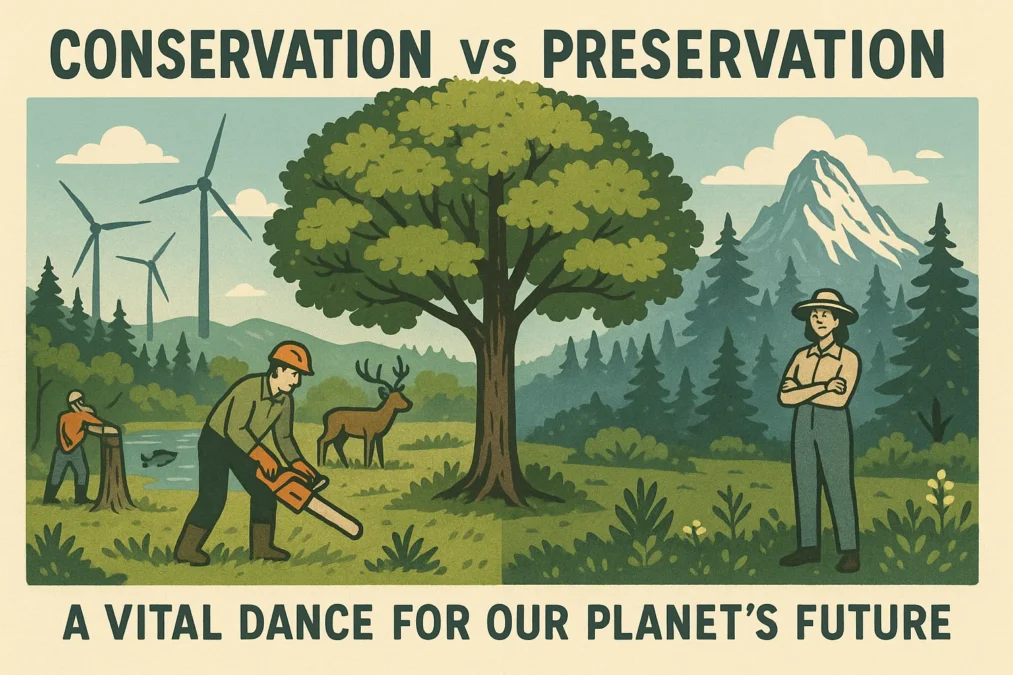Imagine standing in the heart of an ancient, old-growth forest. The air is thick with the scent of damp earth and pine. Sunlight filters through a dense canopy, illuminating a world that has thrived for centuries. Now, a question arises: what is the best way to protect this place? Should we manage its resources, perhaps selectively harvest older trees to prevent disease and promote new growth, using the timber to build our communities? Or should we declare it off-limits, a sanctuary where nature reigns supreme, and human intervention is seen as a violation of its pristine state? This fundamental question lies at the heart of one of the most important environmental debates: conservation vs preservation.
Though these two terms are often used interchangeably in casual conversation, they represent distinct philosophies with profound implications for how we interact with the natural world. Understanding the difference between conservation and preservation is not just an academic exercise; it’s essential for making informed decisions about policy, land management, and our own personal ethics regarding the environment. This deep dive will explore the origins, core principles, key figures, and modern applications of both conservation and preservation, revealing that the path to a sustainable future doesn’t lie in choosing one over the other, but in understanding the vital, nuanced role each one plays.
The Philosophical Roots of Two Environmental Pillars
The ideologies of conservation and preservation both emerged in the late 19th and early 20th centuries as a direct response to the rampant industrialization and exploitation of America’s natural resources. The unregulated logging, mining, and hunting of the era were rapidly depleting landscapes that had once seemed endless. Visionaries began to see that without a dramatic shift in thinking, the nation’s natural treasures would be lost forever. However, these visionaries didn’t all agree on the solution, leading to the birth of two separate, though sometimes overlapping, schools of thought.
The preservation ethic argues for the protection of nature from human use. It posits that wild spaces, species, and ecosystems possess intrinsic value—meaning they are valuable in and of themselves, regardless of any direct benefit they provide to humanity. From this viewpoint, a mountain is not valuable because of the minerals in its rocks; it is valuable because it is a mountain, a majestic and ancient feature of the world that deserves to exist for its own sake. Preservation seeks to maintain nature in its pristine, untouched state, creating areas where natural processes can continue without human alteration or interference. It is, in essence, a form of respect for the autonomy of the natural world.
In contrast, the conservation ethic is grounded in the sustainable use of natural resources. Conservationists believe that nature is vital for human survival and prosperity, providing essential goods and services like clean water, timber, and fertile soil. Therefore, the goal is not to lock nature away, but to manage it wisely and responsibly to ensure these resources are available for both present and future generations. This philosophy embraces the idea of “wise use,” advocating for scientific management and planning to prevent waste, mitigate damage, and allow for the continued, responsible utilization of the environment. It views humans not as separate from nature, but as active, responsible stewards within it.
The Historical Battlefield: Key Figures and the Clash of Ideals Conservation vs Preservation
The story of conservation and preservation in America is deeply intertwined with the lives and conflicts of a few towering figures. Their debates and actions laid the groundwork for the entire modern environmental movement and established the systems of protected lands we know today.
On one side stood Gifford Pinchot, the first Chief of the U.S. Forest Service and a staunch advocate for the conservationist approach. Pinchot was a trained forester who believed in the utilitarian management of public lands. His famous mantra was “the greatest good for the greatest number for the longest time.” For Pinchot, forests were not cathedrals to be worshipped from afar; they were “crops” to be managed scientifically. He advocated for controlled logging, regulated grazing, and the development of water resources to serve human needs, all while ensuring the long-term health and productivity of the land. His influence was immense, shaping the management policies of the national forests for decades.
Championing the opposing preservationist view was John Muir, the famed naturalist, writer, and founder of the Sierra Club. Muir saw the wilderness as a spiritual sanctuary, a place for solace, awe, and connection with something greater than oneself. He famously described the mountains as “not mere hills of grass and granite… but kindly, solemn, care-taking gods.” For Muir, the idea of managing a forest like a farm was sacrilege. His passionate writings galvanized public support for protecting wild places simply for their beauty and inherent value. The most famous clash between these two ideals was over the fate of the Hetch Hetchy Valley in Yosemite National Park. Pinchot supported damming the valley to provide water for the growing city of San Francisco, arguing it was the best use of the resource for the public good. Muir fought the dam vehemently, seeing it as a desecration of a sacred temple. Pinchot’s view ultimately won, and the dam was built—a loss that galvanized the preservation movement and highlighted the deep, often painful, divide between these two critical philosophies.
Conservation in Action: Principles and Real-World Practices
So, what does conservation look like on the ground? It is a hands-on, management-intensive approach that applies scientific principles to achieve sustainable outcomes. The core idea is that we can use nature, but we must do so intelligently and with a long-term perspective.
A prime example of conservation is modern forestry practices. Instead of clear-cutting vast swathes of land, conservation foresters practice selective logging, carefully removing specific trees while leaving the overall ecosystem intact. They engage in replanting efforts, manage for disease and fire risk, and create forest management plans that span decades. This ensures a continuous supply of timber while also maintaining wildlife habitats, watershed health, and recreational opportunities. The forest is used, but it is not used up. It remains a functioning, healthy ecosystem that continues to provide its services.
Another critical application of conservation is in wildlife management. The near-extinction of the American Bison in the 19th century is a stark lesson in what happens without conservation. In response, regulated hunting programs were established. Through the careful setting of hunting seasons and bag limits based on rigorous population data, species like white-tailed deer, wild turkeys, and waterfowl have not only recovered but now thrive. The funding for these efforts, largely through hunting licenses and taxes on equipment (via acts like the Pittman-Robertson Act), is a cornerstone of the conservation model. It creates a direct financial incentive to maintain healthy populations and habitats, demonstrating how sustainable use can fund and fuel environmental protection.
Preservation in Action: Principles and Protected Spaces
If conservation is wise use, preservation is profound respect. It aims to shield ecosystems from development and resource extraction, allowing natural processes—like fire, flood, predation, and succession—to occur with minimal human interference. The goal is to maintain biodiversity benchmarks and protect wilderness character for its own sake.
The most pure expression of the preservation ideal is the designation of a Wilderness Area. As defined by the 1964 Wilderness Act, these are areas “where the earth and its community of life are untrammeled by man, where man himself is a visitor who does not remain.” In these vast tracts of land, mechanized equipment, roads, and permanent structures are prohibited. Trails are maintained, but the land is largely left to its own devices. Fires may burn, rivers may flood their banks, and populations of predators and prey may fluctuate naturally. These areas serve as living laboratories for scientific research and as benchmarks against which we can measure the health of managed landscapes.
National Parks are also a brilliant legacy of the preservation movement, though they often incorporate elements of conservation. Established primarily to protect spectacular scenery and unique natural features, parks like Yellowstone, Yosemite, and Grand Canyon are meant to be “unimpaired for the enjoyment of future generations.” While this involves massive human effort to manage crowds, protect wildlife from human influence, and preserve the visitor experience, the core mission is preservationist: to protect the intrinsic value of these iconic places. The tension within park management—between providing access and preserving wilderness—is a direct reflection of the ongoing dialogue between conservation and preservation ideals.
The Great Modern Convergence: Blending Two Worlds
In the 21st century, the rigid lines between conservation and preservation have begun to blur. Environmental challenges like climate change, invasive species, and habitat fragmentation are so complex that they demand tools from both philosophical toolboxes. The most effective modern environmental strategies often integrate principles from both schools of thought.
The concept of ecosystem management is a perfect example of this synthesis. This approach moves beyond managing for a single species or resource (like timber) and instead manages for the health of the entire ecosystem. This might involve preservationist goals, like protecting critical old-growth forest cores for spotted owl habitat, combined with conservationist actions, like using controlled burns (a management tool) to reduce fuel loads and restore a natural fire regime to the landscape. The burn is a human intervention, but its goal is to restore a more natural, resilient, and preserved state to the ecosystem.
Similarly, the field of restoration ecology operates at this intersection. Efforts to restore a degraded wetland, for instance, are deeply hands-on and managerial—a conservationist approach. Scientists and volunteers may actively plant native species, remove invasives, and re-engineer water flows. Yet the ultimate goal is preservationist: to return the ecosystem to a self-sustaining, wild state where human intervention is no longer necessary. This hybrid model acknowledges that sometimes, we must actively manage and “use” our knowledge and labor to achieve the preservation of a functioning natural world.
Navigating the Gray Areas: Complexities and Ethical Dilemmas
Despite the modern convergence, tough questions remain at the boundary between conservation and preservation. There are no easy answers, and each situation requires careful consideration of ecological, economic, and ethical factors.
Consider the dilemma of renewable energy. To combat climate change—a paramount conservation goal for the sustainability of human civilization—we need to rapidly deploy wind and solar power. However, large-scale solar farms can fragment desert habitats, and wind turbines are a significant cause of bird and bat mortality. Is it acceptable to “use” a wild desert landscape (a conservation choice) to build a solar farm in order to preserve the global climate system? Or should we preserve that specific local habitat (a preservation choice) and seek alternative solutions? This pits a local preservation goal against a global conservation goal, creating a complex ethical puzzle.
Another gray area is the management of charismatic megafauna, like elephants in Africa. In some overpopulated reserves, elephants can destroy their habitat, threatening biodiversity. A strict preservationist might argue that we should let nature take its course, even if it leads to ecosystem collapse and elephant starvation. A conservationist might advocate for culling (the controlled killing of some animals) to maintain the overall health of the herd and the habitat, using the proceeds from ivory sales (if legal) to fund further conservation work. This “sustainable use” argument is deeply controversial, clashing with the preservationist view that each individual animal has intrinsic value. These dilemmas force us to define what we truly mean by “protection” and to confront the uncomfortable reality that non-intervention is itself a form of management decision.
Your Role in the Story: Applying These Ideas Personally
Understanding the difference between conservation and preservation isn’t just for policymakers and land managers; it’s highly relevant to our daily lives and personal choices. We all constantly make decisions that align with one ethic or the other, and often a mix of both.
Your choices as a consumer directly reflect these philosophies. Opting to buy products made from sustainably harvested wood (with certifications like FSC) is a conservation-minded action. You are supporting the responsible use of resources. Choosing to reduce your consumption altogether—buying less, repairing more, and embracing minimalism—leans more towards a preservationist ethic, aiming to minimize your personal draw on the planet’s resources. Similarly, deciding to eat meat from a local ranch that uses regenerative grazing practices (conservation) is different from adopting a vegan diet to reduce overall agricultural impact (leaning towards preservation). Neither choice is inherently “right”; they are simply different applications of a desire to protect the environment.
As a citizen and community member, you can engage with these concepts by supporting organizations that align with your values. You might donate to The Nature Conservancy, which often works on conservation through sustainable use and land acquisition, or to the Sierra Club, which has a strong preservationist history of advocating for wilderness protection. You can attend public meetings about local land-use decisions—should that city-owned forest be a managed natural park with mountain bike trails (conservation) or a designated nature preserve with limited access (preservation)? Your informed voice can help shape the outcome.
The Path Forward: A Symphony, Not a Solo
The debate between conservation and preservation is not a battle to be won. It is a dynamic and essential dialogue. A world governed solely by preservation would be unrealistic, potentially ignoring the needs of humanity and foregoing the tools of active management that many ecosystems now require for health. A world governed solely by conservation risks commodifying all of nature, potentially overlooking the intrinsic value of wildness and the spiritual needs that untouched landscapes fulfill.
The future of environmental protection requires a symphony of both approaches. We need the guarded, sacred spaces of preservation—our national parks, wilderness areas, and marine sanctuaries—that serve as benchmarks for biodiversity and havens for the human spirit. Equally, we need the pragmatic, sustainable management of conservation in our working forests, farms, fisheries, and urban parks, ensuring that human communities can thrive without degrading the ecological systems that support all life.
The true goal is to create a mosaic on the landscape where both ideals are respected and implemented. By understanding the nuanced but crucial difference between conservation and preservation, we can move beyond simplistic arguments and work towards sophisticated, resilient solutions. It is through this integrated approach that we can hope to be good ancestors, leaving a legacy of both thriving human communities and a vibrant, wild, and enduring natural world.
Yellow Gold vs White Gold: The Ultimate Guide to Choosing Your Perfect Metal
Comparison Table: Conservation vs. Preservation
| Feature | Conservation | Preservation |
|---|---|---|
| Core Philosophy | Sustainable and responsible use of natural resources. | Protection of nature from use, maintaining pristine wilderness. |
| View of Nature | A source of vital resources to be managed for human benefit. | Has intrinsic value, worthy of protection for its own sake. |
| Human Role | Active, wise steward and manager. | Passive observer and guardian; a visitor who does not remain. |
| Primary Goal | Ensure long-term availability of resources for people. | Maintain ecosystems in their natural, untouched state. |
| Key Methods | Scientific management, regulated hunting, sustainable logging, controlled burns. | Legal protection, designating wilderness, limiting access and development. |
| Example Figures | Gifford Pinchot, Theodore Roosevelt. | John Muir, John James Audubon. |
| Example Areas | National Forests (USFS land), managed wildlife areas. | Wilderness Areas, National Parks (in their core mission). |
| Funding Model | Often user-pays (e.g., hunting licenses, timber sales). | Often public appropriations and private donations. |
Quotes on Conservation and Preservation
- “The conservation of natural resources is the fundamental problem. Unless we solve that problem, it will avail us little to solve all others.” – Theodore Roosevelt (Conservation)
- “Everybody needs beauty as well as bread, places to play in and pray in, where nature may heal and give strength to body and soul.” – John Muir (Preservation)
- “We abuse land because we regard it as a commodity belonging to us. When we see land as a community to which we belong, we may begin to use it with love and respect.” – Aldo Leopold (Bridging both concepts)
- “Preservation of one’s own culture does not require contempt or disrespect for other cultures.” – Cesar Chavez (Applying the concept more broadly)
Frequently Asked Questions (FAQs)
What is the main difference between conservation and preservation?
The main difference boils down to human use. Conservation promotes the sustainable and responsible use of natural resources (like water, timber, or wildlife) to ensure they are available for future generations. Preservation, on the other hand, advocates for protecting nature from any human use or development, maintaining wilderness areas in their pristine, untouched state for their intrinsic value.
Can you give a simple example of conservation vs. preservation?
Imagine a forest. A conservation approach would involve selectively logging some trees for lumber while scientifically managing the forest’s health through replanting and fire prevention. A preservation approach would argue for designating the entire forest as a wilderness area where no logging, roads, or mechanized equipment are allowed, leaving it to evolve naturally.
Which is more important: conservation or preservation?
Neither is universally more important; they are both critical and complementary strategies. Preservation is vital for protecting biodiversity hotspots, wilderness benchmarks, and areas of profound ecological or scenic value. Conservation is essential for managing the vast majority of the landscape that we use for resources like food, water, and materials in a sustainable way. A healthy planet requires both protected preserves and responsibly managed working lands.
Was Aldo Leopold a conservationist or a preservationist?
Aldo Leopold is a fascinating figure who evolved from a traditional conservationist (he was a forester and promoter of game management) into a thinker who brilliantly synthesized both ideas. His concept of the “land ethic”—which calls for an ethical, caring relationship between people and the land—transcends the simple dichotomy. He understood the need for both use and respect, making him a foundational figure for modern holistic environmentalism.
How does climate change action fit into conservation and preservation?
Combating climate change is arguably the ultimate conservation goal, as it is about ensuring the long-term sustainability of the planet’s life-support systems for human civilization. However, the strategies used can involve both ethics. Building renewable energy infrastructure like solar farms involves using land resources (conservation). Conversely, protecting old-growth forests and peatlands—massive carbon sinks—from any logging or development is a preservationist action that also serves the conservative goal of climate stability.
Conclusion
The journey through the intertwined histories and philosophies of conservation and preservation reveals a narrative not of opposition, but of necessity. This is not a binary choice but a spectrum of stewardship where both approaches are essential. Our greatest environmental successes emerge not from dogmatic adherence to one ideal, but from the wisdom to know when to actively manage a landscape for sustainable yield and when to step back and allow wilderness to simply be. The 21st century’s complex ecological challenges demand this nuanced understanding more than ever. By embracing the pragmatic management of conservation and the profound respect of preservation, we can craft a future where both humanity and the natural world not only survive but flourish together in a balanced, resilient harmony.



